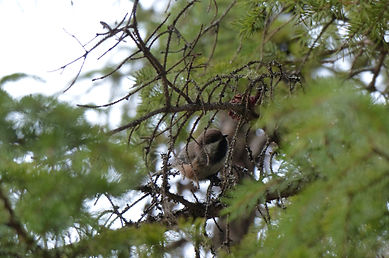
Boreal forest

Plants
The boreal forest is teeming with life. To describe it, let's begin with the trees that make up the forest canopy. There are about 20 species of them, and most are coniferous, which means that they produce their seeds in cones. Spruce, fir, pine, and tamarack are the main species found in the Canadian boreal forest. Except for tamarack, which drops its needles every fall, they remain green all year. Broad-leaf deciduous trees, such as trembling aspen, balsam poplar, and birch, are also widely distributed across the boreal forest.
Under coniferous trees, mosses grow so thickly that they form a complete carpet on the soil's surface, keeping the soil moist and cool and preventing many other types of plants from growing. Open areas are carpeted with yellow, green, and light grey lichens. Some lichens grow on wood too. Lichens are combinations of fungi and algae that benefit each other: the underlying fungus provides structural support for the lichen, while the algal layer on top has chlorophyll which provides food for the lichen through photosynthesis. Lichens remain intact all year long, and are an important food source in winter for species such as caribou.
Wetlands—bogs, fens, and marshes—occupy 30 percent of Canada's boreal forest. Boreal wetlands are often referred to as muskegs or peatlands. These peatlands are usually on poorly drained, flat terrain. Plant material decomposes slowly in the cool, wet soil conditions, forming a blanket of material that is often several metres thick. Sphagnum and other mosses, sedges, and low shrubs make up the peatland vegetation. Treed peatlands, composed mostly of tamarack and black spruce, are also widespread. Some mosses, such as sphagnum, are especially important in peatlands where they can create acidic environments.
Birds
Nearly half of the birds in North America rely on the boreal forest at some time during the year. It is estimated that at least 3 billion landbirds, water birds, and shorebirds breed in the boreal forest each year, representing more than 300 species. Another 300 million birds, including several species of shorebirds, swans, and geese, breed farther north and travel through the boreal forest during migration.

© Aude Rokosz

mammals
The boreal forest shelters more than 85 species of mammals, including some of the largest and most majestic—wood bison, elk, moose, woodland caribou, grizzly and black bears, and wolves—and smaller species, such as beavers, snowshoe hares, Canada lynx, red squirrels, lemmings, and voles.
Of these, the snowshoe hare is the most ecologically important. It is a food source for many of the boreal forest's predators (both mammals and birds) and feeds on the forest's various plants and shrubs, linking all of these species in a tight food web.
© Aude Rokosz
The beaver is one of the most important animals in the boreal forest. Using its ever-growing front teeth, it fells trees and eats the leaves, twigs, and bark, using the wood to build dams and lodges. Beaver dams flood parts of the forest, creating ponds and wetlands that are used by fish, waterfowl, and amphibians.
Insects
It is estimated that 32 000 insect species inhabit Canada's boreal forest, although about one third of these species have yet to be described. Among the known species, several are particularly well adapted to their habitat. For example, black fire beetles have infrared sensing organs on their bodies that allow them to track the heat of forest fires as they search for freshly burned trees on which to lay their eggs.

© Aude Rokosz
Other species, like the white-spotted sawyer beetle, use their long antennae to sense chemicals in smoke and charcoal to achieve the same goal. Like many other insect species, in addition to starting the decomposition of fire-killed trees, these two beetle species are an important part of the diet of several bird species commonly found in burned forests.







